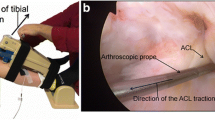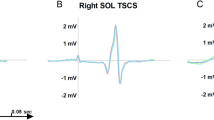Abstract
After injuries to the anterior cruciate ligament (ACL) a functional instability is frequently observed which has been attributed to a disturbed sensorimotor function. In light of the clinical importance of ACL injuries and the resulting functional instability, it is of enormous clinical interest to elucidate the role of sensorimotor pathways that involve the ACL. In animals and humans a direct reflex pathway between the ACL and the hamstrings has been shown. The onset latencies of responses reported after ventral tibia translation were around 40–50 ms (range 17.9–65) and were regarded as medium latency responses (MLR). However, ventral tibia translation should also induce a stretch of the hamstring muscles and evoke a short latency response (SLR). Before any muscle response after ventral tibia translation can be ascribed to anatomical structures, it is crucial to analyze the obtained muscle responses carefully. The aim of the present study was the development of an algorithm to differentiate SLR and MLR responses after ventral tibia translation. In ten healthy subjects reflex responses of the hamstrings after anterior tibia translation and after tendon taps on the biceps femoris tendon were evaluated. To investigate the influence of skin afferents, control experiments were performed after lidocain injection of the dorsal calf. The mean onset latency of the tendon jerk reflex was 21.9±3.1 ms (range 17.3–28.7 ms). Both SLR responses (mean onset latency: 20.3±3.5 ms; range 15.4–25.8) and MLR responses (mean onset latency: 38.9±4.2 ms; range 32.9–46.7) were obtained in all subjects. Skin afferents from the calf do not play a major role. The development of an evaluation algorithm is presented that allows a safe differentiation between these partly superimposed SLR and MLR components. It is demonstrated that by measuring the first part of the SLR from the onset to the first peak the end of the SLR can be predicted and that the onset latency of the MLR component can be assessed reliably. Possible reasons are discussed why previous studies only reported responses at MLR latencies. The fact that both SLR and MLR components can be observed after anterior tibia translation underlines the necessity to differentiate the responses before they can be ascribed to any anatomical structures. As a basis for future work the algorithm presented may become a useful tool to differentiate which afferent pathways play a role in initiating hamstring activity.






Similar content being viewed by others
References
Basmajian J, De Luca C (1985) Muscles Alive. Williams & Wilkins
Beard DJ, Kyberd PJ, Fergusson CM, Dodd CA (1993) Proprioception after rupture of the anterior cruciate ligament. An objective indication of the need for surgery? J Bone Joint Surg Br 75:311–315
Beard DJ, Dodd CA, Trundle HR, Simpson AH (1994a) Proprioception enhancement for anterior cruciate ligament deficiency. A prospective randomised trial of two physiotherapy regimes. J Bone Joint Surg Br 76:654–659
Beard DJ, Kyberd PJ, Dodd CA, Simpson AH, O’Connor JJ (1994b) Proprioception in the knee. J Bone Joint Surg Br 76:992–993
Beard DJ, Kyberd PJ, O’Connor JJ, Fergusson CM, Dodd CA (1994c) Reflex hamstring contraction latency in anterior cruciate ligament deficiency. J Orthop Res 12:219–228
Biedert RM, Stauffer E, Friederich NF (1992) Occurrence of free nerve endings in the soft tissue of the knee joint. A histologic investigation. Am J Sports Med 20:430–433
Bruhn S (1999) Improved measurement of knee-joint stability. The Michael-Jager Prize for a Stuttgart research group. Orthopade 28:819
Burke D, Gandevia SC, McKeon B (1984) Monosynaptic and oligosynaptic contributions to human ankle jerk and H-reflex. J Neurophysiol 52:435–448
Dhaher YY, Tsoumanis AD, Rymer WZ (2003) Reflex muscle contractions can be elicited by valgus positional perturbations of the human knee. J Biomech 36:199–209
Diener HC, Dichgans J, Bootz F, Bacher M (1984) Early stabilization of human posture after a sudden disturbance: influence of rate and amplitude of displacement. Exp Brain Res 56:126–134
Dietz V, Berger W (1982) Spinal coordination of bilateral leg muscle activity during balancing. Exp Brain Res 47:172–176
Dietz V, Mauritz KH, Dichgans J (1980) Body oscillations in balancing due to segmental stretch reflex activity. Exp Brain Res 40:89–95
Durselen L, Claes L, Kiefer H (1995) The influence of muscle forces and external loads on cruciate ligament strain. Am J Sports Med 23:129–136
Dyhre-Poulsen P, Krogsgaard MR (2000) Muscular reflexes elicited by electrical stimulation of the anterior cruciate ligament in humans. J Appl Physiol 89:2191–2195
Faist M, Blahak C, Duysens J, Berger W (1999) Modulation of the biceps femoris tendon jerk reflex during human locomotion. Exp Brain Res 125:265–270
Freeman MA, Wyke B (1967) Articular reflexes at the ankle joint: an electromyographic study of normal and abnormal influences of ankle-joint mechanoreceptors upon reflex activity in the leg muscles. Br J Surg 54:990–1001
Friden T, Roberts D, Ageberg E, Walden M, Zatterstrom R (2001) Review of knee proprioception and the relation to extremity function after an anterior cruciate ligament rupture. J Orthop Sports Phys Ther 31:567–576
Fujita I, Nishikawa T, Kambic HE, Andrish JT, Grabiner MD (2000) Characterization of hamstring reflexes during anterior cruciate ligament disruption: in vivo results from a goat model. J Orthop Res 18:183–189
Grey MJ, Ladouceur M, Andersen JB, Nielsen JB, Sinkjaer T (2001) Group II muscle afferents probably contribute to the medium latency soleus stretch reflex during walking in humans. J Physiol 534:925–933
Gruber J, Wolter D, Lierse W (1986) Anterior cruciate ligament reflex (LCA reflex). Unfallchirurg 89:551–554
Haus J, Halata Z (1990) Innervation of the anterior cruciate ligament. Int Orthop 14:293–296
Haus J, Halata Z, Refior HJ (1992) Proprioception in the anterior cruciate ligament of the human knee joint—morphological bases. A light, scanning and transmission electron microscopy study. Z Orthop Ihre Grenzgeb 130:484–494
Imran A, O’Connor J (1998) Control of the knee stability after ACL injury or repair: interaction between hamstrings contraction and tibial translation. Clin Biomech (Bristol, Avon) 13:153–162
Jennings AG, Seedhom BB (1994) Proprioception in the knee and reflex hamstring contraction latency. J Bone Joint Surg Br 76:491–494
Jerosch J, Prymka M (1997) Proprioceptive deficits of the knee joint after rupture of the medial meniscus. Unfallchirurg 100:444–448
Krogsgaard MR, Dyhre-Poulsen P, Fischer-Rasmussen T (2002) Cruciate ligament reflexes. J Electromyogr Kinesiol 12:177–182
Miyatsu M, Atsuta Y, Watakabe M (1993) The physiology of mechanoreceptors in the anterior cruciate ligament. An experimental study in decerebrate-spinalised animals. J Bone Joint Surg Br 75:653–657
More RC, Karras BT, Neiman R, Fritschy D, Woo SL, Daniel DM (1993) Hamstrings—an anterior cruciate ligament protagonist. An in vitro study. Am J Sports Med 21:231–237
Nardone A, Grasso M, Giordano A, Schieppati M (1996) Different effect of height on latency of leg and foot short- and medium- latency EMG responses to perturbation of stance in humans. Neurosci Lett 206:89–92
Raunest J, Sager M, Burgener E (1998) Proprioception of the cruciate ligaments: receptor mapping in an animal model. Arch Orthop Trauma Surg 118:159–163
Reider B, Arcand MA, Diehl LH, Mroczek K, Abulencia A, Stroud CC, Palm M, Gilbertson J, Staszak P (2003) Proprioception of the knee before and after anterior cruciate ligament reconstruction. Arthroscopy 19:2–12
Schieppati M, Nardone A, Siliotto R, Grasso M (1995) Early and late stretch responses of human foot muscles induced by perturbation of stance. Exp Brain Res 105:411–422
Schultz RA, Miller DC, Kerr CS, Micheli L (1984) Mechanoreceptors in human cruciate ligaments. A histological study. J Bone Joint Surg Am 66:1072–1076
Schutte MJ, Dabezies EJ, Zimny ML, Happel LT (1987) Neural anatomy of the human anterior cruciate ligament. J Bone Joint Surg Am 69:243–247
Sjolander P, Johansson H, Sojka P, Rehnholm A (1989) Sensory nerve endings in the cat cruciate ligaments: a morphological investigation. Neurosci Lett 102:33–38
Solomonow M, Krogsgaard M (2001) Sensorimotor control of knee stability. A review. Scand J Med Sci Sports 11:64–80
Solomonow M, Baratta R, Zhou BH, Shoji H, Bose W, Beck C, D’Ambrosia R (1987) The synergistic action of the anterior cruciate ligament and thigh muscles in maintaining joint stability. Am J Sports Med 15:207–213
Toft E, Sinkjaer T, Andreassen S (1989) Mechanical and electromyographic responses to stretch of the human anterior tibial muscle at different levels of contraction. Exp Brain Res 74:213–219
Zimny ML, Schutte M, Dabezies E (1986) Mechanoreceptors in the human anterior cruciate ligament. Anat Rec 214:204–209
Author information
Authors and Affiliations
Corresponding author
Rights and permissions
About this article
Cite this article
Friemert, B., Bumann-Melnyk, M., Faist, M. et al. Differentiation of hamstring short latency versus medium latency responses after tibia translation. Exp Brain Res 160, 1–9 (2005). https://doi.org/10.1007/s00221-004-1980-4
Received:
Accepted:
Published:
Issue Date:
DOI: https://doi.org/10.1007/s00221-004-1980-4




